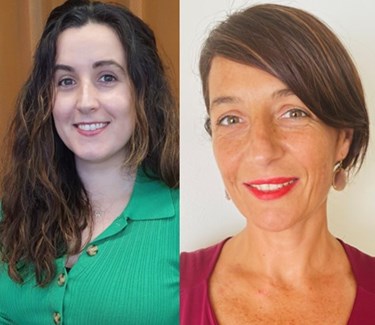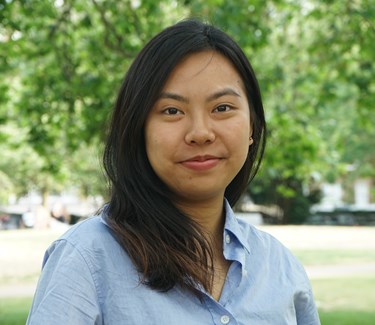Congratulations to all the finalists at the RTPI Awards for Research Excellence 2023. You can see all finalists below:
Early Career Researcher Award

Dongsheng He, The University of Hong Kong
The effects of metro interventions on physical activity and walking among older adults: A natural experiment in Hong Kong

Dongsheng He, The University of Hong Kong
The effects of metro interventions on physical activity and walking among older adults: A natural experiment in Hong Kong
This paper provides causal inference on how metro intervention affects physical activity and walking among older adults in Hong Kong, using a natural experiment approach. A longitudinal survey of 449 cohort participants was collected before and after the metro operation. Results showed that the new metro significantly decreased older adults' weekly physical activity, while the effect on change in walking time was not significant. Furthermore, older adults’ physical activity and walking levels may stabilize six months after metro operation. Our results suggested that the presumed health benefits of the metro system should be reconsidered in the high-density cities.

Dr. Si Qiao, The University of Hong Kong
Who are the gig workers? Evidence from mapping the residential locations of ride-hailing drivers by a big data approach

Dr. Si Qiao, The University of Hong Kong
Who are the gig workers? Evidence from mapping the residential locations of ride-hailing drivers by a big data approach
The study examines the residential location of gig drivers using mobile phone data and field study to identify the sociodemographic characteristics and built environments of the neighbourhoods where ride-hailing drivers are clustered. Findings suggest that ride-hailing drivers come from neighbourhoods with lower-income and less regular job opportunities, forming living clusters with urban villages, resettlement houses, and shanty towns. It argues that gig work does not liberate workers from structural disparities but continues to reinforce barriers in the division of labour. The results could aid in standardizing non-standard forms of self-employment and solve issues of immigration and social integration in cities.

Dr. Rachel Valbrun, University College London
Land, disasters, and built-environment professionals: Examining urban design for post-disaster reconstruction

Dr. Rachel Valbrun, University College London
Land, disasters, and built-environment professionals: Examining urban design for post-disaster reconstruction
This thesis examines the relationships between social processes and built environment practices with land tenure and how they influence vulnerability to and recovery from disasters. It aims to understand how, in Port-au-Prince, Haiti, after the 2010 earthquake, urban designs for rebuilding physical space consider, and potentially replicate, vulnerability to disasters. Centre-ville, the historic downtown district of Port-au-Prince, exemplifies these interrelations between land tenure and post-disaster reconstruction. The findings demonstrate how land tenure influences vulnerability and the necessity for urban designers and planners to incorporate a comprehensive understanding of local methods to secure land in reconstruction plans to support recovery.
You can read and download Dr Valbrun's thesis here: https://discovery.ucl.ac.uk/id/eprint/10152186/

Robert Wade, Queen's University Belfast
Reclaiming the Windy Commons: Landownership, Wind Rights, and the Assetization of Renewable Resources

Robert Wade, Queen's University Belfast
Reclaiming the Windy Commons: Landownership, Wind Rights, and the Assetization of Renewable Resources
This research explores the ownership of wind resources using the notion of ‘wind rights’. It argues that landowners are enclosing wind resources via ‘proxy wind rights’. Drawing analogy to historical debates around coal and oil rights, and based on empirical case studies in Ireland and the Netherlands, it makes a case for socially-orientated property rights arrangements, including community wind rights or nationalisation of wind resources. The significance in this analysis lies in its potential to open new ways of thinking about governance and spatial planning in energy transitions which are otherwise obscured when land and wind rights are bundled together.
Planning Practitioner Award

Kim Power and Sara Candiracci, Arup, UNDP and University of Liverpool
Cities Alive: Designing Cities that Work for Women

Kim Power and Sara Candiracci, Arup, UNDP and University of Liverpool
Cities Alive: Designing Cities that Work for Women
The global publication “Designing Cities that Work for Women”, developed by Arup, the United Nations Development Programme (UNDP), and the University of Liverpool (UoL) presents key evidence on challenges and opportunities that women of different age, socio-economic background, ethnicity, and sexual orientation, experience across different global urban contexts. Drawing on primary research findings, including a global survey and international workshops, together with a review of secondary research, the report provides actionable recommendations and guidance for urban professionals on how to design and plan for cities that are more inclusive, safer, and equitable for women and in turn, for everybody.
You can read, explore, and download the research report here: https://www.arup.com/perspectives/publications/research/section/cities-alive-designing-cities-that-work-for-women

Christopher Schiele and Catriona Fraser, Turley
Turley - Co-Location Report 2023

Christopher Schiele and Catriona Fraser, Turley
Turley - Co-Location Report 2023
Turley's Co-Location Report 2023 researched whether the innovative mixed-use development model known as 'Co-Location' - referring to the knitting together of residential and industrial land uses - presents a deliverable solution to the London Plan's need to maintain, and where possible intensify, London's existing industrial land while delivering much-needed housing. Reviewing all strategic Co-Location schemes submitted for planning permission between January 2019 and December 2022, it concludes that the concept can make a significant contribution to the delivery of increased employment capacity and new housing, and provides a detailed overview of its many characteristics. The research will be updated annually.

Martin Taylor, Lichfields
Banking on brownfield

Martin Taylor, Lichfields
Banking on brownfield
A suite of policy discussions and politicians have suggested brownfield land as the solution to meeting the country’s housing needs. This report considers whether brownfield land is sufficient in size, in location and in its deliverability, to perform that role. We compare brownfield capacity with local housing need in each housing market area, then consider affordability, viability, the types of homes that can come forward compared with local markets, levelling up ambitions and the effect on demand and then conclude the limitation of a brownfield first policy.

Louise Thomas and Geoff Noble, Historic Towns and Villages Forum and the Alliance of Historic Cathedrals and Towns, and Allies and Morrison Urban Practitioners
Towards a Better Balance Between Heritage and Growth

Louise Thomas and Geoff Noble, Historic Towns and Villages Forum and the Alliance of Historic Cathedrals and Towns, and Allies and Morrison Urban Practitioners
Towards a Better Balance Between Heritage and Growth
This Study responds to pressing concerns in spatial planning and has key lessons about the public's understanding of town planning, as well as professional development. The Study is unique as it is based on a grassroots understanding of places, their planning and management from the perspective of 12 civic societies, and correlated in interviews with local planning authority officers and members.
It makes more than 40 recommendations for the government, Historic England, local planning authorities and civic societies to address. These include the contributions that voluntary and community groups can make to expanding public engagement and supplementing resources in planning.
Student Award

Danielle Brooke, Anglia Ruskin University
An index to evaluate public green spaces: The case of Fenland in Cambridgeshire

Danielle Brooke, Anglia Ruskin University
An index to evaluate public green spaces: The case of Fenland in Cambridgeshire
The Fenland Open Space Index (FOSI) is a tool created to evaluate public urban green spaces in Fenland market towns. It considers factors such as accessibility, nature, infrastructure, and amenities to quantify the quality of green spaces. FOSI aims to provide a comprehensive assessment of spaces to inform decision-making and improve the quality of life for residents. The evaluation can identify areas that need improvement and can guide future development plans to ensure adequate and suitable green spaces. The FOSI assessment can also be used to compare different market towns and identify best practices in providing quality urban green spaces.

Laura Hemsley, Jacobs
The effectiveness of strategic planning arrangements in mineral planning

Laura Hemsley, Jacobs
The effectiveness of strategic planning arrangements in mineral planning
Planning for minerals supply is an essential but often overlooked area of planning (RTPI, 2020a). However, the NPPF suggests mineral planning is not considered a priority as it is only briefly alluded to in the final chapters. Its arguable that the Government does not give mineral planning as much weight as other planning considerations such as housing, heritage and design. A coherent link between minerals (aggregates and soft sand) is imperative for development of future houses and infrastructure. Unless there is a sufficient supply of minerals, the Government’s aspirations for housing and economic growth will not be achieved (RTPI, 2020b).

Sin Yu Ashley Ng, The University of Hong Kong
Outdoor thermal environment of open space in public housing in Hong Kong

Sin Yu Ashley Ng, The University of Hong Kong
Outdoor thermal environment of open space in public housing in Hong Kong
As climate change escalates, local research has studied the thermal environment of open spaces but with little focus on the overall performance of those in 252 public housing estates in Hong Kong. With a territorial level GIS analysis and two local level on-site measurements, 85.34% of open spaces are found to be thermally comfortable but are not fully utilised for users due to land use mismatch. Given the potential of having similar mismatch in other existing spaces, this paper reveals a need to review the planning of existing public housing open spaces and calls for attention towards climate sensitive planning.

Ka Lai Tsang, The University of Hong Kong
Re-examination and Optimisation of Green Infrastructure Quality: creating heat resilient neighbourhood in a high density city

Ka Lai Tsang, The University of Hong Kong
Re-examination and Optimisation of Green Infrastructure Quality: creating heat resilient neighbourhood in a high density city
This research formulates an evaluation framework for reassessing the quality of green infrastructure (GI) and proposes systematic green optimisation strategies for enhancing the quality of GI and creating a heat-resilient neighbourhood adapting to extreme heat in a high density city. High heat risk area – Yau Mong neighbourhood is selected as a representative case study. Design strategies consisting of quality evaluation, green optimisation and green planning are proposed to systematically improve the quality of GI in the focus areas, the neighbourhood and the city as a whole for creating a thermally comfortable environment.
The Sir Peter Hall Award for Excellence in Research and Engagement

Prof. Claudia Carter and Mr. Simeon Shtebunaev, Birmingham City University
Climania - The Climate Action Game: Engaging youngsters and communities in sustainable built environment planning

Prof. Claudia Carter and Mr. Simeon Shtebunaev, Birmingham City University
Climania - The Climate Action Game: Engaging youngsters and communities in sustainable built environment planning
The CLIMANIA boardgame was co-created as a community engagement, learning and action tool in a series of seven workshops by 13 teenagers from Birmingham working with Birmingham City University researchers and urban environment professionals. The prototype was tested in community play events, revised and then produced as an open access resource. The rationale for the project and goal of the game is to inform participants and players of built environment contributions to the climate emergency and to encourage action to help mitigate and adapt to climate change through urban planning and design measures with a specific focus on retrofitting buildings.
You can see Prof Carter and Mr Shtebunaev's boardgame and other research outputs here: https://climaniathegame.com/

Prof. Nick Gallent, UCL with Dr Phoebe Stirling and Dr Iqbal Hamiduddin, UCL & Dr Meiling Wu, Singapore Management University
Village Housing: Constraints and Opportunities in Rural England

Prof. Nick Gallent, UCL with Dr Phoebe Stirling and Dr Iqbal Hamiduddin, UCL & Dr Meiling Wu, Singapore Management University
Village Housing: Constraints and Opportunities in Rural England
'Village Housing: Constraints and Opportunities in rural England' situates an analysis of past, current and future housing delivery in its broader political economy of private land rights, public intervention, finance, and taxation. Using a mix of archival research and local case studies, it explores the constraints affecting current housing delivery models, and the opportunities that exist, through different planning, finance and tax approaches, to deliver the homes that rural communities need in the future.

Dr. Matluba Khan, Dr Tom Smith, Dr Neil Harris, and Shoruk Nekeb, Cardiff University
A Grangetown to grow up in: Children and young people's plan for Grangetown, Cardiff

Dr. Matluba Khan, Dr Tom Smith, Dr Neil Harris, and Shoruk Nekeb, Cardiff University
A Grangetown to grow up in: Children and young people's plan for Grangetown, Cardiff
Working with children and young people from communities in Cardiff the project co-produces a greener and fairer, child-friendly recovery plan for Grangetown, through a series of workshops and engagement activities. The project takes a child and youth-centred approach, and emphasised co-creation with them as often their voices remain unheard in the process of design and urban planning. The recovery plan for child-friendly Grangetown is shared with local authorities to inform decision-making and is aided with a toolkit for planners and designers that can be applied to engage children in plan-making in other communities in Cardiff, and throughout the UK.

Dr. Pablo Sendra, UCL
The Ethics of Co-Design

Dr. Pablo Sendra, UCL
The Ethics of Co-Design
There is a lack of definition in policy of the term co-design, and yet local authorities and developers are increasingly using it. To avoid that this term becomes meaningless, it is essential to define how to run co-design processes ethically. Building on case studies, professional experience, collaborations with communities, and a Participatory Action Research approach, this paper defines a set of principles on how to run a co-design process ethically and genuinely including communities in decision-making. Departing from the legal Principles for Fair Consultation in England and Wales, the paper expands them and results into ten ethical principles for co-design.

Dr. Yiyang Yang and Dr. Chao Ren, University of Hong Kong
Moderation effect of visible urban greenery on the association between neighbourhood deprivation and subjective well-being

Dr. Yiyang Yang and Dr. Chao Ren, University of Hong Kong
Moderation effect of visible urban greenery on the association between neighbourhood deprivation and subjective well-being
Using emerging urban data and techniques, the inter-disciplines research team explores the complex relationship between different aspects of urban greenery spatial structure, neighbourhood deprivation and subjective well-being in high-density Asian context. We found that subjective well-being level was negatively associated with social fragmentation and positively associated with overall greenery and visible greenery. Additional moderation effect analysis reveals that the negative linkage between social fragmentation and subjective well-being was significantly mitigated by visible greenery. Findings from current research help urban planners and designers to better address the inequalities in health and well-being issues and achieve Sustainable Development Goals in planning practice.